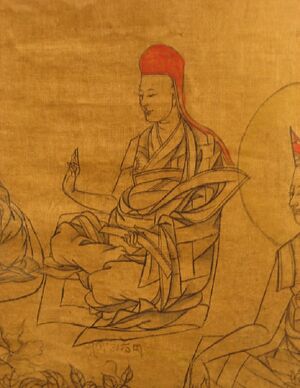Post-36
| Line 3: | Line 3: | ||
|blogDate=June 2021, Week 4 | |blogDate=June 2021, Week 4 | ||
|blogTitle=Śākya Chokden’s History of the Middle Way School | |blogTitle=Śākya Chokden’s History of the Middle Way School | ||
| + | |blogImage=File:Shakya Chokden.jpg | ||
|blogContent=[[People/ShAkya_mchog_ldan|Paṇchen Śākya Chokden]] is perhaps the earliest Tibetan scholar to write a history of Madhyamaka thought. In his [[Texts/Dbu_ma%27i_byung_tshul_rnam_par_bshad_pa%27i_gtam_yid_bzhin_lhun_po_zhes_bya_ba%27i_bstan_bcos|''Discourse on the History of Madhyamaka entitled Wish-fulfilling Mountain'']] (དབུ་མའི་བྱུང་ཚུལ་རྣམ་པར་བཤད་པའི་གཏམ་ཡིད་བཞིན་ལྷུན་པོ་ཞེས་བྱ་བའི་བསྟན་བཅོས།), he defines what Middle Way is and presents the transmission of the different Middle Way schools of thought. At the outset he points out that all Buddhists follow the Middle Way, while the non-Buddhist philosophical systems fall to the extremes. Thus, the view of the Middle Way is a hallmark of the Buddhist system and explains how even the substantialist schools of thought, which include Cittamātra, claim to adopt a philosophical Middle Way. | |blogContent=[[People/ShAkya_mchog_ldan|Paṇchen Śākya Chokden]] is perhaps the earliest Tibetan scholar to write a history of Madhyamaka thought. In his [[Texts/Dbu_ma%27i_byung_tshul_rnam_par_bshad_pa%27i_gtam_yid_bzhin_lhun_po_zhes_bya_ba%27i_bstan_bcos|''Discourse on the History of Madhyamaka entitled Wish-fulfilling Mountain'']] (དབུ་མའི་བྱུང་ཚུལ་རྣམ་པར་བཤད་པའི་གཏམ་ཡིད་བཞིན་ལྷུན་པོ་ཞེས་བྱ་བའི་བསྟན་བཅོས།), he defines what Middle Way is and presents the transmission of the different Middle Way schools of thought. At the outset he points out that all Buddhists follow the Middle Way, while the non-Buddhist philosophical systems fall to the extremes. Thus, the view of the Middle Way is a hallmark of the Buddhist system and explains how even the substantialist schools of thought, which include Cittamātra, claim to adopt a philosophical Middle Way. | ||
Revision as of 13:04, 14 October 2021
Śākya Chokden’s History of the Middle Way School[edit]
Paṇchen Śākya Chokden is perhaps the earliest Tibetan scholar to write a history of Madhyamaka thought. In his Discourse on the History of Madhyamaka entitled Wish-fulfilling Mountain (དབུ་མའི་བྱུང་ཚུལ་རྣམ་པར་བཤད་པའི་གཏམ་ཡིད་བཞིན་ལྷུན་པོ་ཞེས་བྱ་བའི་བསྟན་བཅོས།), he defines what Middle Way is and presents the transmission of the different Middle Way schools of thought. At the outset he points out that all Buddhists follow the Middle Way, while the non-Buddhist philosophical systems fall to the extremes. Thus, the view of the Middle Way is a hallmark of the Buddhist system and explains how even the substantialist schools of thought, which include Cittamātra, claim to adopt a philosophical Middle Way.
The main topic of the text is the history of what is commonly known as the Madhyamaka school, which is considered the fourth and highest tenet system in the Tibetan scholarly world. Śākya Chokden divides this into two groups: the Yogacāra and the Niḥsvabhāvavādin. He argued that the former, based on the five treatises of Maitreya, adopted a Middle Way which is free from subject-object dualism and centered on the self-conscious nature of the mind. He emphatically distinguishes this from the view of Cittamātra, as the luminous or self-conscious mind, which constitutes the Middle Way in this tradition, is the sphere of reality or dharmadhātu, and not mere mind. The Niḥsvabhāvavādin, or proponents of lack of own-being, he argued, abided in the Middle Way by avoiding eternalism, as they argued that all phenomena do not truly exist, and by avoiding nihilism, as such negation is not forced through reasoning or other causes but is the true nature of things. In the course of this, he criticizes the interpretation given by later Tibetan scholars, that this Middle Way school abides in the Middle Way and avoids eternalism by rejecting hypostatic existence and avoids nihilism by accepting conventional existence.
Śākya Chokden also presents the Middle Way topic in the two categories of the nonanalytical Middle Way experienced through meditation (རྣམ་པར་མ་བརྟགས་པ་སྒོམ་པས་ཉམས་སུ་མྱོང་བའི་དབུ་མ་) and the analytical Middle Way which cuts the superimposition of characteristics (རྣམ་པར་བརྟགས་པ་མཚན་འཛིན་གྱི་སྒྲོ་འདོགས་གཅོད་པའི་དབུ་མ་). The former is equated with buddha-nature, pristine wisdom of reality, emptiness endowed with supreme aspects, etc., and taught in the third wheel and the tantras, while the latter, taught primarily in the Perfection of Wisdom sūtras of the Middle Wheel, is identified with the emptiness established by study, emptiness which is a nonimplicative negation, emptiness which excludes aggregates, etc. He also classifies Middle Way into a) the Middle Way system of all phenomena without own-being taught in scholastic works of Nāgārjuna, b) the Middle Way system of propounding the absolute as nature taught in the works of Maitreya, and c) the Middle Way of the tantras.
Having discussed the different understandings of the Middle Way, Śākya Chokden presents the history of Middle Way thought in India and Tibet. He begins the history in India with a claim that Saraha, who is a slightly early contemporary of Nāgārjuna, spread the teachings of the Middle Way through his songs, although Nāgārjuna is generally considered the pioneer of the Middle Way school. This is then followed by his account of how the Middle Way traditions from Nāgārjuna and Maitreya and the Middle Way of secret mantra first spread in India and was later propagated in Tibet. He gives the names of the many masters who advocated the different interpretations of the Middle Way philosophy and championed the various subschools of Middle Way thought. While presenting the gist of their interpretation, Śākya Chokden also refutes the later Tibetan interpretations, most of which are associated with the new Gelukpa school.
Śākya Chokden’s history, written at the behest of the 7th Karmapa, Chödrak Gyatso, is perhaps the earliest Tibetan record giving a fairly detailed account of the masters of the Middle Way, their students, seats, and philosophical positions. He also amply demonstrates his own inclination for the Middle Way of other-emptiness and the espousal of the Great Middle Way, or innate reality qua buddha-nature, which is absolute and empty of only temporary afflictions and impurities. The full text can be viewed here.
Weekly quote[edit]
~

